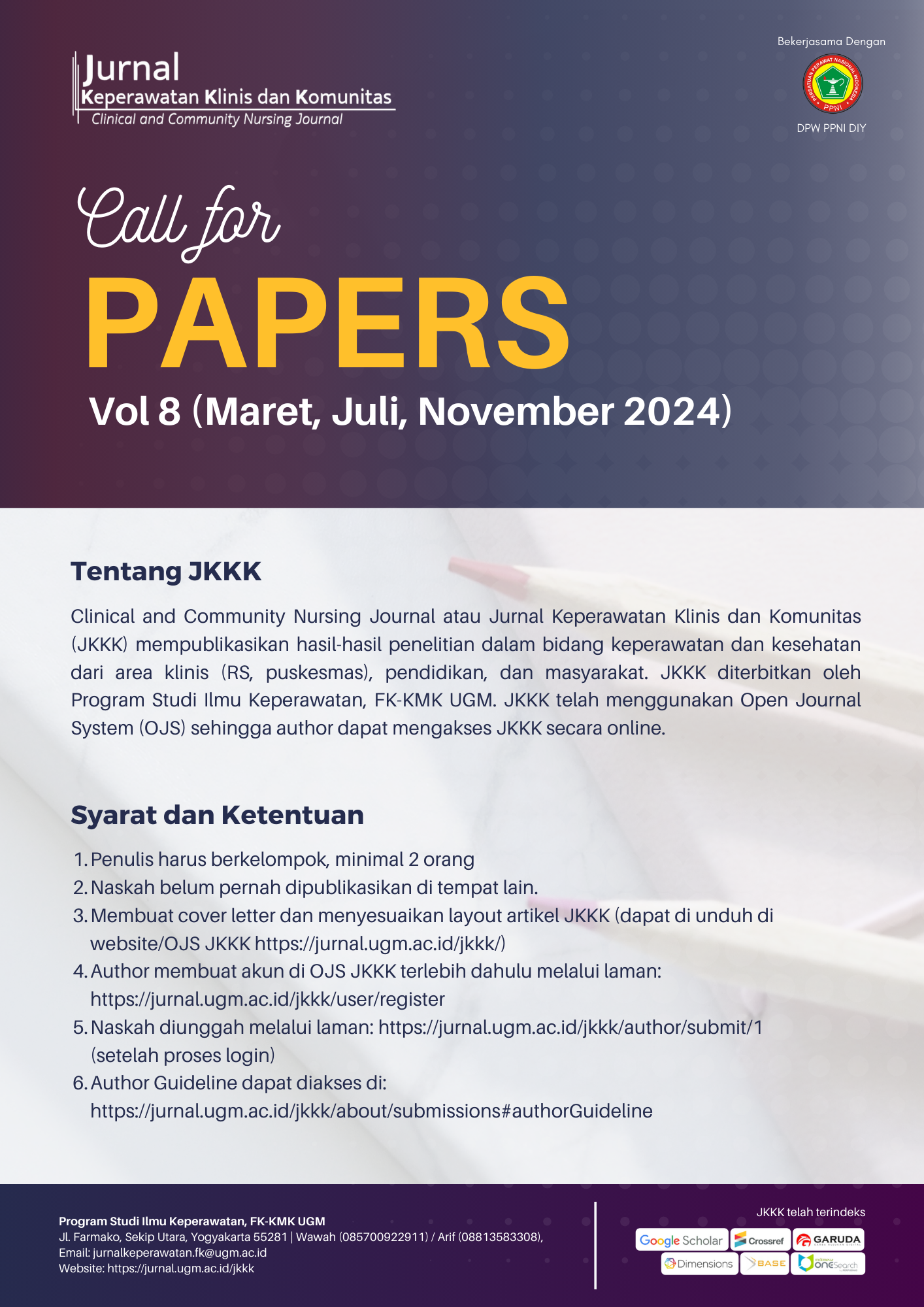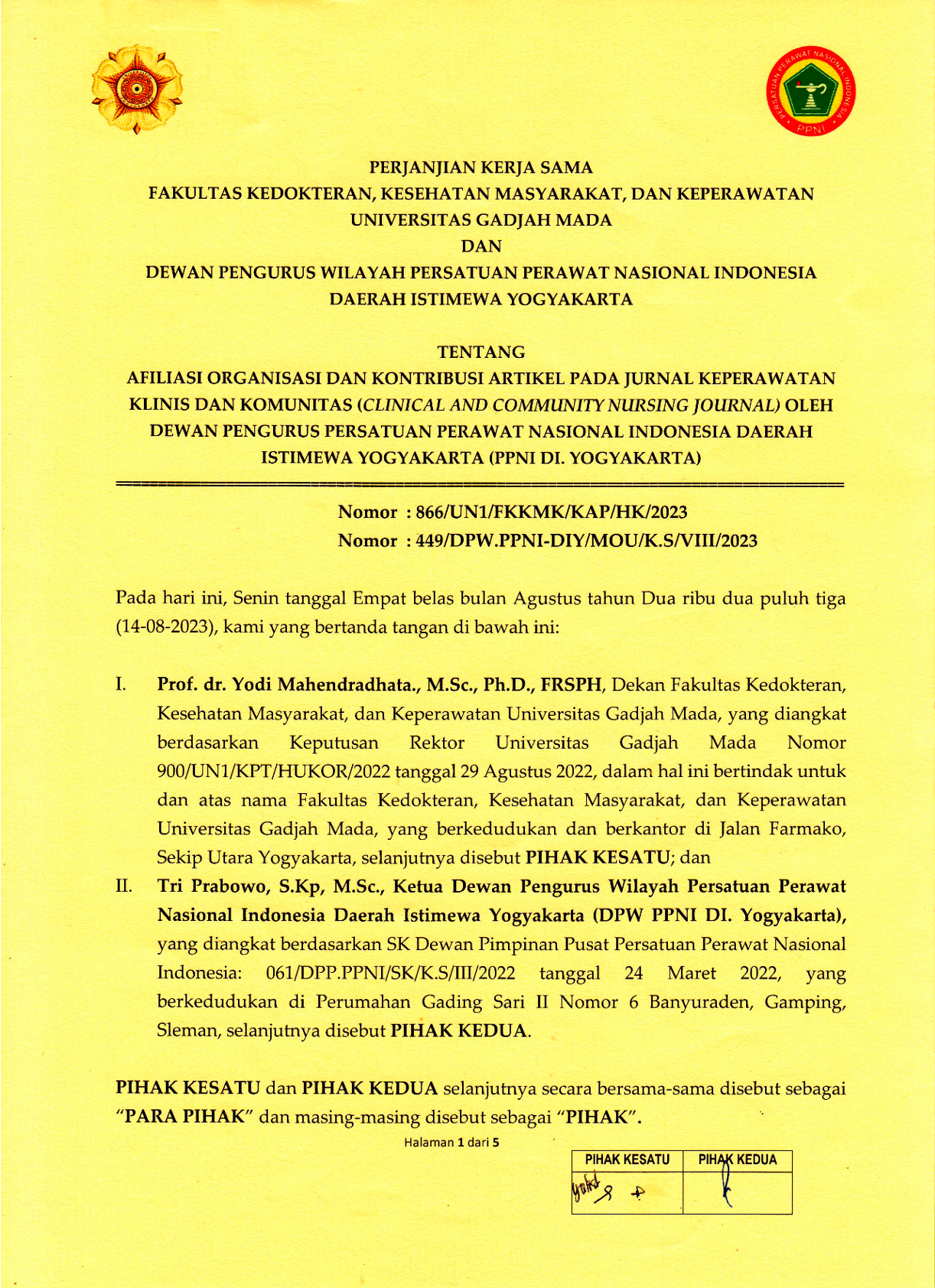Faktor-Faktor Yang Beresiko Terjadinya Pasien Stagnan Di Instalasi Gawat Darurat Rumah Sakit
Puti Damayanti(1*), Sutono Sutono(2)
(1) RS Mata Dr. YAP, Yogyakarta
(2) Departemen Keperawatan Dasar dan Emergensi Program Studi Ilmu Keperawatan Fakultas Kedokteran, Kesehatan Masyarakat, dan Keperawatan Universitas Gadjah Mada
(*) Corresponding Author
Abstract
Background: Fast response is needed in the Emergency Room (ER). However, the high number of patient visit leads stagnant patient in ER. The impact of patient stagnant can affect other patient safety and quality of services in the hospital.
Objective: Identify factors related to the presence of stagnant patients in the ER of Dr. Sardjito General Hospital.
Methods: This study used a retrospective case control method. The total samples in this study is 87 samples and divided into two groups, 29 samples for non-stagnant group and 58 samples for stagnant group. Data collection used non-probability sample with purposive sampling method for the sample selection. Sampling was carried out at 16 to 28 January 2015 in ER of Dr. Sardjito General Hospital. This research uses Chi Square and logistic regression to data analyze.
Results: Risk factors to stagnant patients are the availability of beds (p: <0.001), corresponding ward grouping disease patients (p: 0.021), fogging (p: 0.008), age of the patient (p: <0.001), patients came hours ( p: 0.019) and the number of actions in Emergency Room (p: 0.002). From the results of logistic regression the most influential factor for the patients is the availability of beds (15 times more risky).
Conclusions: Factors related to patients are the availability of a stagnant, according grouping wards patient's disease, fogging, patient age, patient coming hours and the number of actions.
ABSTRAK
Latar belakang: Pelayanan yang cepat sangat dibutuhkan di IGD. Akan tetapi kondisi kunjungan pasien di IGD yang cukup banyak dapat menimbulkan pasien stagnan di IGD . Dampak pasien yang stagnan mempengaruhi keselamatan pasien yang lain dan mutu pelayanan rumah sakit tersebut.
Tujuan: Mengetahui faktor-faktor yang berisiko terjadinya pasien yang stagnan di Instalasi Gawat Darurat Rumah Sakit Umum Pusat Dr. Sardjito Yogyakarta.
Metode: penelitian ini menggunakan metode case control retrospektif dengan jumlah sampel masing-masing 29 sampel untuk kelompok non-stagnan dan 58 sampel untuk kelompok stagnan. Pengambilan data dilakukan dengan cara non-probability sample dengan metode purposive sampling. Pengambilan sampel dilakukan pada 16-28 Januari 2015 di IGD RSUP Dr. Sardjito Yogyakarta. Analisa yang digunakan di dalam penelitian ini antara lain Chi Square dan regresi logistik.
Hasil: Faktor-faktor yang berisiko pasien stagnan antara lain ketersediaan tempat (p:<0,001), bangsal sesuai pengelompokkan penyakit pasien (p:0,021), fogging(p:0,008), usia pasien(p:<0,001), jam datang pasien(p:0,019) dan jumlah tindakan(p:0,002). Dari hasil regresi logistik faktor yang paling berisiko dengan terjadinya pasien stagnan adalah ketersediaan tempat (15 kali lebih berisiko)
Kesimpulan : Faktor-faktor yang berhubungan dengan pasien stagnan antara lain ketersediaan tempat, bangsal sesuai pengelompokkan penyakit pasien, fogging, usia pasien, jam datang pasien dan jumlah tindakan.
Keywords
Full Text:
PDFReferences
Queensland Health. Implementation Standard for Emergency Department Short Stay Unit Version 1.0. Queensland Government. 2012.
Australasian College for Emergency Medicine. Emergency Department Design Guidlines. 2014. [Cited 2015 august 7]. Available from https://www.acem.org.au/Standards-Publications/Policies-Guidelines.aspx.
Australasian College for Emergency Medicine. Statement on Access Block. [Cited 2015 august 7]. Available from https://www.acem.org.au/Standards-Publications/Policies-Guidelines.aspx.
Singer, Thode, Viccellio, Pines. The Association Between Length of Emergency Department Boarding and Mortality. Academic Emergency Medicine. 2011(12): 1324-1329.
Forero, McCarthy, Hillman. Access Block and Emergency Department Overcrowding. Critical Care. 2011(15): 216-221.
10 Facts on Patient Safety. 2014. [Cited 2014 September 15]. Available from http://www.who.int/features/factfiles/patient_safety/en/.
Lapau, Buchari. Metode Penelitian Kesehatan : Metode Ilmiah Penulisan Skripsi, Tesis, dan Disertasi. Jakarta:Yayasan Pustaka Obor Indonesia. 2012.
Au, Byrnes, Bain, Fackrell, Brand, Campbell, Taylor. Predicting overflow in an emergency department. IMA Journal of Management Mathematics. 2009(20):39-49.
Khanna, Boyle, Good, dan Lind. Unravelling Relationships:Hospital Occupancy Levels, Discharge Timing and Emergency Department Access Block. Emergency Medicine Australasia. 2012(24):510-517.
Paolini, Richard dan Dawn Fowler. Total Access Block Time: A Comprehensive and Intuituve Way to Measure the Total Effect of Access Block on the Emergency Department. Emergency Medicine Australasia. 2008(20):16-22.
Keputusan Menteri Kesehatan Republik Indonesia Nomor 1204/Menkes/SK/X/2004, Persyaratan Kesehatan Lingkungan Rumah Sakit. Jakarta. 2004.
Ye, Zhou, He, Shen, Gan, dan Zhang. Prolonged length of stay in the emergency department in high-acuity patients at a Chinese tertiary hospital. Emergency Medicine Australasia. 2012(24): 634-640.
Hodgins, Moore, dan Legere. Who Is Sleeping in Our Beds? Factors Predicting the ED Boarding of Admitted Patients for More Than 2 Hours. J Emerg Nurs. 2011(37): 225-230.
Forero, Roberto dan Ken Hillman. Access Block and Overcrowding : A Literature Review. Simpson Centre for Health Services Research, Universuty of New South Wales. 2008.
Hsu, Shu, Lin, Yang dan Ko. Why Do General Medical Patient Have a Lengthy Wait in the Emergency Department Before Admission? Journal of the Formosan Medical Association. 2014(113):557-561.
White et al. Boarding Inpatients In The Emergency Department Increases Discharged Patient Length of Stay. The Journal of Emergency Medicine. 2013(1): 230-235.
Bartlett, Simone dan Daniel M Fatovich. Emergency Department Patient Preferences for Waiting for a Bed. Emergency Medicine Australasia. 2009(21):25-30.
Li, Chiu, Kung, Chen. Factors Affecting Length of Stay in the Pediatric Emergency Department. Pediatrics and Neonatology. 2012(54): 179-187.
Article Metrics
Refbacks
- There are currently no refbacks.
Copyright (c) 2017 Puti Damayanti, Sutono

Jurnal Keperawatan Klinis dan Komunitas (Clinical and Community Nursing Journal)
collaborates with DPW PPNI DIY
![]()
Jurnal Keperawatan Klinis dan Komunitas (Clinical and Community Nursing Journal) is licensed under a Creative Commons Attribution-ShareAlike 4.0 International License.




